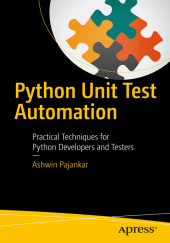 Neuerscheinungen 2017Stand: 2020-02-01 |
Schnellsuche
ISBN/Stichwort/Autor
|
Herderstraße 10
10625 Berlin
Tel.: 030 315 714 16
Fax 030 315 714 14
info@buchspektrum.de |

Ashwin Pajankar
Python Unit Test Automation
Practical Techniques for Python Developers and Testers
1st ed. 2017. xix, 111 S. 19 Farbabb. 235 mm
Verlag/Jahr: SPRINGER, BERLIN; APRESS 2017
ISBN: 1-484-22676-3 (1484226763)
Neue ISBN: 978-1-484-22676-6 (9781484226766)
Preis und Lieferzeit: Bitte klicken
Quickly learn how to automate unit testing of Python 3 code with Python 3 automation libraries, such as doctest, unittest, nose, nose2, and pytest.
This book explores the important concepts in software testing and their implementation in Python 3 and shows you how to automate, organize, and execute unit tests for this language. This knowledge is often acquired by reading source code, manuals, and posting questions on community forums, which tends to be a slow and painful process.
Python Unit Test Automation will allow you to quickly ramp up your understanding of unit test libraries for Python 3 through the practical use of code examples and exercises. All of which makes this book a great resource for software developers and testers who want to get started with unit test automation in Python 3 and compare the differences with Python 2.
This short work is your must-have quick start guide to mastering the essential concepts of software testing in Python.
What You´ll Learn:
Essential concepts in software testing
Various test automation libraries for Python, such as doctest, unittest, nose, nose2, and pytest
Test-driven development and best practices for test automation in Python
Code examples and exercises
Who This Book Is For:
Python developers, software testers, open source enthusiasts, and contributors to the Python community
Chapter 1: Introduction to Python The chapter will introduce readers to the testing concepts and Python 3. Readers will be able to setup the Python 3 environment on their computers. It will also list the differences between Python 2 and Python 3.
Chapter 2: Getting Started This chapter will be a light and short chapter. It will be very easy to follow. In this chapter, readers will be introduced to hands-on test automation in Python 3.
Chapter 3: Unittest This will be the largest chapter in terms of page count and contents. Readers will be introduced to the unittest framework for test automation. Additionally, it will have detailed explanation for philosophy of xUnit style of frameworks. Readers will learn a particular style of coding which they will follow throughout the book.
Chapter 4: Nose and Nose2 In this chapter readers will explore nose and nose2. They will also explore few plugins for nose.
Chapter 5: Pytest In this chapter, readers will explore pytest, the most recent and arguably the best unit test automation framework for Python 3.
Chapter 6: Tips and Tricks In this chapter, readers will be introduced with the concept of TDD in python with Pytest. They will also learn the best practices for the test automation.
"It provides a clear introduction to the options available for Python unit test automation, while at the same time introducing many general points about what one needs in a testing framework. For anyone who has begun writing Python programs, but is unsure about how to write automated tests for those programs, this book provides excellent guidance on how to get started." (Computing Reviews, August, 2016)


